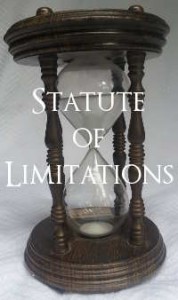Tolling the Statute of Limitations in Criminal Cases: CPL 30.10(3)(f), the Special Case of Course of Sexual Conduct in the First Degree
People v. Pabon
New York Court of Appeals
2016 NY Slip Op 07108
Decided on November 1, 2016

Issue: Whether defendant’s prosecution was untimely pursuant to the limitations periods found in CPL 30.10 (3)(e) and (3)(f) where the sex crime was committed when the victim was about 7 years old and went unreported until the victim attained 21 years of age.
Holding: The Court of Appeals held that defendant’s prosecution was not untimely because prosecution for defendant’s crime falls under the tolling provision within CPL 30.10 (3)(f) and the court held that 30.10(3)(e) was not applicable in this case.
Facts: Defendant was indicted on one count of course of sexual conduct in the first degree (Penal Law 130.75 [1][a]) when he sexually assaulted a seven-year-old girl between 1998 and 1999. In 2012, defendant was charged when the victim disclosed the acts of abuse to police at the age of twenty-one. Defendant moved to dismiss the indictment as time-barred, arguing that the existence of CPL 30.10 (3)(e) would be unnecessary if CPL (3)(f) tolled the limitations period. The Supreme Court denied the motion.
The Appellate Division affirmed defendant’s conviction.
Legal Analysis: CPL 30.10 (2)(b) provides that the statute of limitations is five years for all non class-A felonies, including course of sexual conduct in the first degree. In 1996, the legislature enacted Penal Law 130.75 creating the crime for which defendant was convicted, course of sexual conduct against a child in the first degree (L 1996, ch 122, 6). At the same time the legislature added subsections CPL 30.10 (3)(e) and (f) which provide the following:
CPL 30.10 (3)(e): “A prosecution for course of sexual conduct in the first degree as defined in section 103.75 of the penal lawmay be commenced within five years of the commission of the most recent act of sexual conduct.”
CPL 30.10 (3)(f): “[f]or purposes of a prosecution involving a sexual offense as defined in article one hundred thirty of the penal law committed against a child less than eighteen years of age . . . the period of limitation shall not begin to run until the child has reached the age of eighteen or the offense is reported to a law enforcement agency or statewide central register of child abuse and maltreatment, whichever occurs earlier.”
While CPL 30.10 (2)(b) provides an umbrella under which a five-year limitation period applies to all non class-A felonies, CPL 30.10 (3)(e) specifies the commencement of the limitations period (at the time of the most recent act). CPL 30.10 (3)(f) further specifies that the commencement period should begin when the victim turns eighteen or when the abuse is disclosed to authorities, whichever happens first.
Legislature eliminated the statute of limitations in CPL 30.10 (3)(e) for course of sexual conduct against a child in the first degree in 2006, and in its place, by amendment to CPL 30.10 (2)(a), provided that prosecution of this crime “may be commenced at any time” (CPL 30.10, as amended by L 2006, ch 3). The legislature intended that the change apply retroactively to offenses whose respective statutes of limitations had not expired by the effective date of the amendment (citing 2006 McKinney’s Session Laws of NY, ch 3, 5 [June 2006]; see generally Stogner v California, 549 US 607 [2003]).
Here, defendant argued that the court should not apply subsection (3)(f) to his prosecution if (3)(e) can also apply. Defense asserted that (3)(e) and (3)(f) provided two distinct limitations period commencements and that if the court applied (3)(f) to his prosecution, it would render subsection (3)(e) superfluous. If the court were to apply CPL 30.10(3)(e) to defendant’s prosecution, his limitations period would end in 2004, five years after the last act of conduct. However, the Court of Appeals (affirming the Appellate Division) did not agree with defendants interpretation of the statutes. The Court of Appeals held that subsection (3)(f) tolls the statute of limitations period provided by (3)(e), making the limitations period end five years after the victim turned 18, or in 2014.
First, the Court of Appeals addressed legislative history and intent to support their decision. Prior to 1996, the crime of “course of sexual conduct against a child” did not exist, and each crime needed to be placed on a specific timeline in order to prosecute each crime. Congress noted the difficulty for child victims to remember specific details of each event, and for this reason, they created the “course of sexual conduct” crime to encompass a period of sexual assault over three months or more. This allows prosecution of these defendants without needing specific dates or times of each act of the three-month period. The court reasoned that:
“Based on the reality that child victims are less capable of providing specific detail as to the dates and times of each sexual assault committed over an extended period time, claims of continued abuse went unprosecuted because child victims often could not remember the dates when the sexual assaults had occurred or how many times they were assaulted in that same period of time. In 1996, the legislature voted to remove this impediment to the prosecution of those who commit repeated sex crimes against minors during a period of time in excess of three months. The 1996 amendment, which created the crime of course of sexual conduct against a child and the five-year statute of limitations set forth in CPL 30.10 (3)(e), rendered repeated sexual assaults ‘continuing crimes,’ which ‘can be prosecuted and proven regardless of whether child-victims can specify the particular dates and times of the individual acts of sexual conduct’ (Governor’s Program Bill #39R 1996 Memorandum). Simply put, CPL 30.10 (3)(e) was intended to address the obstacles to prosecution by recognizing that a series of multiple sexual assaults of a child over an extended period of time is, indeed, a continuous crime.”
With regard to the tolling provision, prior to the amendment, the limitations period for a sexual assault against a child of four years would expire when the child turned nine. The 1996 enactment of CPL 30.10 (3)(f) halts the statute of limitations until the child turns eighteen. These tolling modifications allow easier prosecution of sex crimes against children who may be scared to come forward before they reach the age of 18.
The Court of Appeals also addressed logic and reasoning, holding that courts are “governed by the principal that we must interpret a statute so as to avoid an unreasonable or absurd application of the law” (citing People v. Garson, 6 NY3d 604, 614 [2006]). The Court of Appeals exhibited defendant’s lack of logic and reasoning in his interpretation of the statutes with two examples. First, defendant’s interpretation would start the limitations period clock at the age of nine for a child abused at age four. The enactment of subsection (3)(f), however, would set the limitations period clock to begin at age 23. The Court of Appeals argued that legislature’s intentions were set on removing obstacles to prosecutions and that “child victims are hesitant or fearful of disclosing such crimes” (citing People v. Quinto, 18 NY3D?at 412). Second, the defendant’s argument that single acts of conduct against a minor should be tolled, while the five-year limitation should apply to crimes involving multiple acts against a minor is illogical. The defendants argument would provide incentive for an abuser to commit multiple acts of conduct. The Court of Appeals held that such interpretation is “unconscionable or antithetical to the legislative objectives” (citing Assn. of Criminal Defense Lawyers, 96 N.Y.2d at 519).

